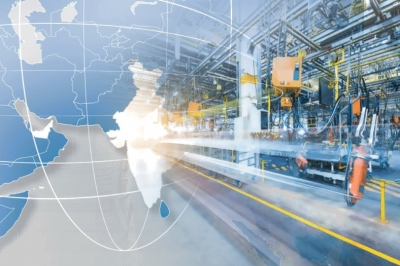Investments under PLI schemes cross Rs 1.76 lakh crore as India evolves into a global manufacturing hub
By IANS | Updated: August 24, 2025 17:50 IST2025-08-24T17:41:41+5:302025-08-24T17:50:28+5:30
New Delhi, Aug 24 With investments exceeding Rs 1.76 lakh crore and major gains in output, exports, and ...

Investments under PLI schemes cross Rs 1.76 lakh crore as India evolves into a global manufacturing hub
New Delhi, Aug 24 With investments exceeding Rs 1.76 lakh crore and major gains in output, exports, and employment generation, the Centre’s Production Linked Incentive (PLI) Scheme has played a key role in transforming India from a country that was heavily reliant on imports to a serious contender in global manufacturing.
The production impact has been remarkable, with total sales by PLI participants exceeding Rs 16.5 lakh crore, reflecting impressive growth in key sectors such as electronics, pharmaceuticals, automotive, and textiles, according to an official statement issued on Sunday.
The PLI initiative has also emerged as a major job creator, generating over 12 lakh direct and indirect employment opportunities, while simultaneously fostering additional ecosystem development across Tier-2 and Tier-3 cities. Importantly, the scheme has catalysed a fresh wave of FDI into the country, endorsing India as a preferred destination for high-value manufacturing in an evolving global scenario, the statement said.
With an incentive outlay of Rs 1.97 lakh crore, the scheme is more than just a financial package. Today, with 806 applications approved across 14 strategic sectors, the scheme reflects strong industry confidence and robust adoption.
The PLI Scheme stands as a cornerstone of India’s ambition to raise manufacturing’s contribution to 25 per cent of GDP and claim its place among the world’s leading industrial economies.
Over time, the scheme attracted strong interest from both domestic and global players, leading to approvals of multiple projects in sectors such as electronics, bulk drugs, medical devices, and textiles. For example, in February 2021, the Union Cabinet approved the PLI scheme for the pharmaceuticals sector with an outlay of Rs 15,000 crore. Similarly, in September 2021, a Rs 25,938 crore PLI scheme for the automobile and auto component industry and a PLI scheme for Drones and Drone Components with funding of Rs 120 crore for 3 years was cleared.
By November 2024, committed investments under the PLI scheme had reached Rs 1.61 lakh crore. This momentum carried into 2025, with realised investments rising to about Rs 1.76 lakh crore with 806 approved applications as more projects shifted from approval to active implementation.
The electronics sector has emerged as a flagship success story under the PLI strategy, with production surging by 146 per cent, from Rs 2.13 lakh crore in FY 2020-21 to Rs 5.25 lakh crore in FY 2024-25. The PLI Scheme has encouraged major smartphone companies to shift their production to India. As a result, India has become a major mobile phone manufacturing country.
In the automobile & auto components sector, the PLI scheme has attracted committed investments worth Rs 67,690 crore. As of March 2024, Rs 14,043 crore has been invested, generating over 28,884 jobs. These schemes aim to make India a global EV and clean-tech hub by supporting and driving sustainable mobility aligned with the Faster Adoption and Manufacturing of Electric Vehicles (FAME) initiative.
The food processing sector has seen the approval of 171 applications under the PLI scheme till October 2024, with investments of over Rs 8,910 crore, while a sum of Rs 1,084 crore has been disbursed in incentives. The scheme complements initiatives like PM-Formalisation of Micro Food Processing Enterprises (PM-FME) and Pradhan Mantri Kisan SAMPADA Yojana (PMKSY), aiming to modernise processing units, enhance branding of Indian food products, and boost value-added exports.
India’s pharmaceutical drugs sector, which was once heavily dependent on imports for essential raw materials with net imports (Rs 1,930 crore deficit in FY 2021-22), has, under the PLI scheme, transitioned to a net exporter of bulk drugs to the tune of Rs 2,280 crore in FY 2024-25. In the first three years, pharma sales under PLI crossed Rs 2.66 lakh crore, including exports worth Rs 1.70 lakh crore. The overall domestic value addition in the sector has been 83.7 per cent as of March 2025.
Similarly, under the PLI scheme for high-efficiency solar PV modules, investments worth Rs 48,120 crore have been committed, generating nearly 38,500 direct jobs as of June 30.
In a world driven by chips, India is also scripting its own semiconductor story with six approved semiconductor projects already in various stages of execution. The Union Cabinet has approved four additional manufacturing units in Odisha, Punjab, and Andhra Pradesh. These projects, sanctioned under the India Semiconductor Mission (ISM) with an outlay of Rs 4,600 crore, are expected to create direct employment for 2,034 skilled professionals and stimulate the broader electronics manufacturing ecosystem, leading to significant indirect job generation. With a vision to build a self-reliant semiconductor ecosystem by 2030, the government has rolled out dedicated incentives under the India Semiconductor Mission, complementing the broader PLI framework.
The PLI Scheme for Textiles was approved with an outlay of Rs 10,683 crore in September 2021, to promote the production of man-made fibre (MMF) apparel, MMF fabrics and products of technical textiles in the country to enable the textile sector to achieve size and scale and to become competitive. Man-made Fibre (MMF) exports rose to around Rs 525 crore in FY 2024–25, from Rs 499 crore in FY 2023–24), while technical textile exports climbed to Rs 294 crore, up from Rs 200 crore the previous year.
The PLI scheme for white goods, which was launched in April 2021 with an outlay of Rs 6,238 crore, aims to transform India from an assembly hub to a high-value manufacturing base. It targets a jump in domestic value addition from just 20–25 per cent to 75–80 per cent by 2028–29, the statement added.
Disclaimer: This post has been auto-published from an agency feed without any modifications to the text and has not been reviewed by an editor
Open in app